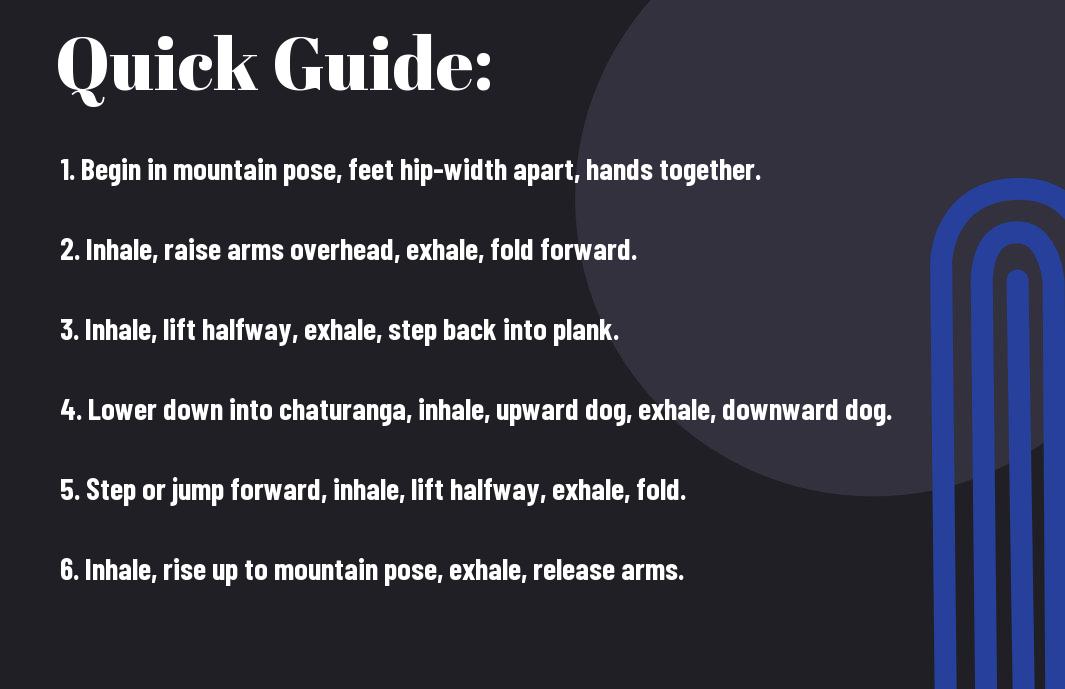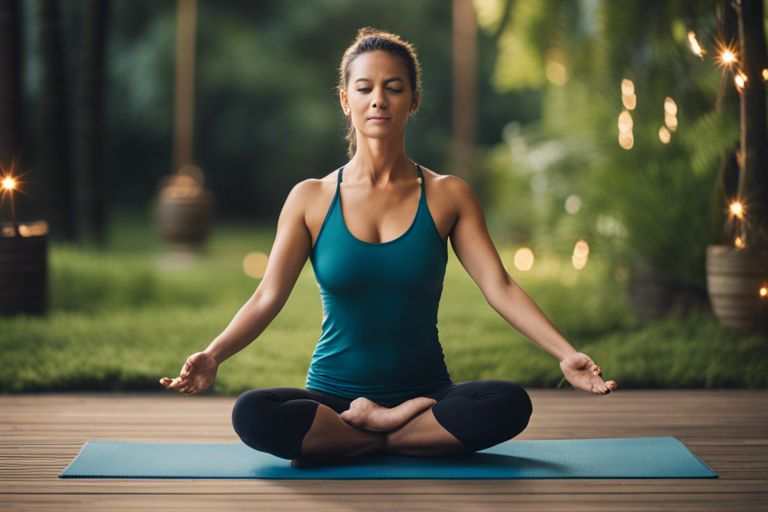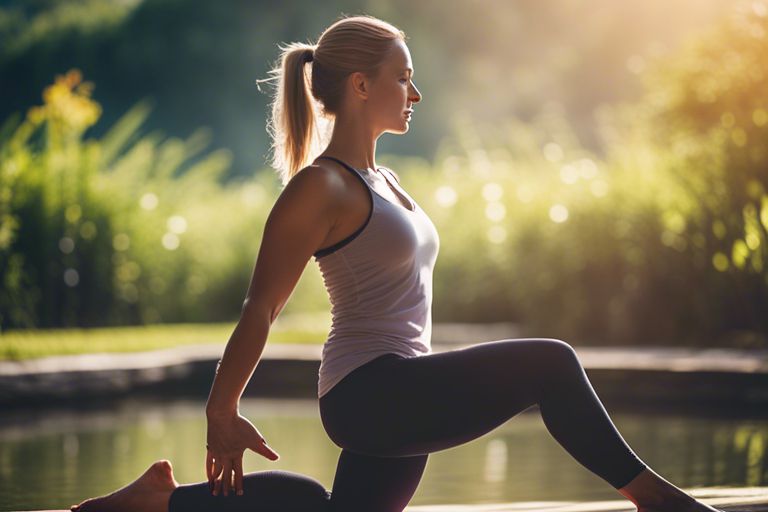Overwhelmed by the world of yoga? Vinyasa yoga might just be the perfect fit for you. This dynamic practice seamlessly combines breath with movement, creating a flowing sequence that not only improves flexibility and strength but also helps in calming the mind. In this beginner’s guide, we’ll explore the necessary movements and provide step-by-step instructions to help you explore the transformative world of Vinyasa yoga with confidence and ease.
Key Takeaways:
- Clear Instruction: Understanding the proper form and alignment in each vinyasa movement is imperative for beginners to prevent injury and fully benefit from the practice.
- Breath Awareness: Learning how to synchronize breath with movement helps in creating a fluid and meditative practice, enhancing the mind-body connection.
- Modify and Adapt: It is important for beginners to listen to their bodies, modify poses when needed, and gradually build strength and flexibility to progress in their vinyasa practice.

Understanding Vinyasa Yoga
What is Vinyasa Yoga?
Yoga is a practice that combines breath with movement to create a flow of poses. Vinyasa Yoga specifically focuses on the coordination of breath and movement, emphasizing the transitions between poses as much as the poses themselves. This style of yoga is known for its fluidity and continuous movement, as each pose seamlessly flows into the next.
Types of Vinyasa Yoga
If you’re new to Vinyasa Yoga, it’s crucial to understand the various types that exist. Some popular types include Power Yoga, Ashtanga Vinyasa Yoga, and Rocket Yoga. These variations have different intensities and sequences, catering to practitioners with various preferences and skill levels. Recognizing the differences between these styles can help you choose the one that best suits your needs and goals.
| Power Yoga | Focuses on strength and flexibility, with dynamic sequences. |
| Ashtanga Vinyasa Yoga | Follows a specific sequence of poses that progressively increase in difficulty. |
| Rocket Yoga | A fast-paced practice that combines elements of Ashtanga and Vinyasa Yoga. |
| Vinyasa Flow | Emphasizes the continuous flow of movement between poses. |
| Yin Yang Yoga | Combines Vinyasa flow with longer-held poses to target deeper tissues. |
If you want to examine deeper into the practice, explore the different types of Vinyasa Yoga to find the one that resonates with you the most. Each style offers a unique experience and benefits, so don’t be afraid to try out a few classes to see which one suits you best. Recognizing your preferences can enhance your yoga journey and keep you motivated to practice regularly.
Benefits of Practicing Vinyasa Yoga
Understanding the benefits of Vinyasa Yoga can help you appreciate the value it brings to both your physical and mental well-being. This style of yoga not only improves flexibility, strength, and stamina but also promotes mindfulness and relaxation. The synchronization of breath and movement in Vinyasa Yoga can help you cultivate a deeper connection between your body and mind.
For many practitioners, the benefits of Vinyasa Yoga extend beyond the physical aspect, offering a sense of mental clarity, stress relief, and emotional balance. This holistic approach to wellness makes Vinyasa Yoga a popular choice for those looking to enhance both their physical health and emotional well-being. By incorporating Vinyasa Yoga into your routine, you can experience a comprehensive transformation that strengthens your body and calms your mind.
Essential Movements for Beginners
It is vital for beginners to familiarize themselves with the foundational movements in Vinyasa Yoga. If you’re new to this practice, it may be helpful to refer to resources like Vinyasa Yoga: All You Need to Know to Get Started to understand the basic poses and sequences.
Foundational Poses
On your journey to mastering Vinyasa Yoga, foundational poses such as Mountain Pose, Downward-Facing Dog, Plank, and Cobra are crucial. These poses help build strength, improve flexibility, and establish proper alignment in your practice.
Sun Salutations
Foundational in Vinyasa Yoga, Sun Salutations are a series of poses that create a flowing sequence. They help warm up the body, increase circulation, and set the pace for a Vinyasa flow class.
Understanding the Sun Salutations sequence is key to transitioning smoothly between poses and connecting breath with movement. This sequence typically involves movements like Forward Fold, Plank, Chaturanga, Upward-Facing Dog, and Downward-Facing Dog.
Standing Poses
While practicing Vinyasa Yoga, standing poses like Warrior I, Warrior II, and Tree Pose help improve balance, stability, and focus. These poses also strengthen the legs, core, and improve overall posture.
It is important to engage your muscles and ground through your feet in standing poses to maintain stability and prevent strain on the joints. Standing poses can also help build confidence and increase body awareness.
Seated Poses
With poses like Seated Forward Fold, Seated Twist, and Pigeon Pose, seated poses in Vinyasa Yoga focus on stretching the hips, hamstrings, and lower back. These poses help release tension in the body and promote relaxation.
Standing or sitting cross-legged in seated poses, you can focus on lengthening the spine and folding forward from the hips to deepen the stretch. These poses are excellent for improving flexibility and releasing tightness in the muscles.
Balancing Poses
On your Vinyasa Yoga journey, balancing poses like Tree Pose, Eagle Pose, and Dancer Pose are vital for enhancing focus, concentration, and stability. These poses challenge your balance and core strength while improving coordination.
For instance, practicing balancing poses can help improve proprioception (awareness of body position) and strengthen the muscles around the ankles and feet. Balancing poses also cultivate a sense of presence and mindfulness in your practice.
Forward Folds and Backbends
To deepen your practice, incorporating forward folds like Seated Forward Fold and Standing Forward Fold, as well as backbends like Cobra Pose and Upward-Facing Dog, can provide a well-rounded experience. These poses help stretch the spine, open the chest, and increase flexibility.
Plus, forward folds and backbends help improve posture, relieve tension in the back and neck, and invigorate the body. Practicing a combination of these poses can help balance out the body and enhance the overall benefits of your Vinyasa Yoga practice.
Step-by-Step Instructions for Key Poses
To provide a comprehensive guide for beginners in Vinyasa yoga, it’s crucial to break down the key poses with detailed instructions. Understanding the proper alignment and execution of each pose is crucial for a safe and effective practice. Let’s explore the step-by-step instructions for some fundamental poses in Vinyasa yoga.
Downward-Facing Dog
On Downward-Facing Dog:
| Step | Instructions |
| 1 | Start in a tabletop position with hands shoulder-width apart and knees hip-width apart. |
| 2 | Lift your hips up and back, straightening your arms and legs to form an inverted V shape. |
Warrior II
On Warrior II:
| Step | Instructions |
| 1 | Begin in a standing position, then step your feet wide apart, aligning the front heel with the back arch. |
| 2 | Extend your arms out to the sides at shoulder height, with your palms facing down. |
Warrior II is a powerful pose that builds strength and stability in the legs, opens the hips, and improves focus and concentration.
Triangle Pose
Poses Triangle Pose:
| Step | Instructions |
| 1 | Begin in Warrior II position, then straighten your front leg. |
| 2 | Shift your hips back as you reach forward with your front arm, placing your hand on your shin, ankle, or a block. |
Understanding the alignment in Triangle Pose is key to gaining the full benefits of the stretch. This pose helps to strengthen the legs, stretch the sides of the body, and improve balance.
Seated Forward Fold
Forward Seated Forward Fold:
| Step | Instructions |
| 1 | Sit on the floor with legs extended in front of you. |
| 2 | Hinge at the hips to fold forward, reaching for your feet or shins. |
This calming pose stretches the spine, hamstrings, and lower back while promoting relaxation and introspection.
Tree Pose
While Tree Pose:
| Step | Instructions |
| 1 | Stand with feet hip-width apart, then shift your weight onto your left foot. |
| 2 | Place your right foot on your inner left thigh or calf, avoiding the knee area. |
This balancing pose improves stability, strengthens the legs, and enhances concentration and focus. Practice Tree Pose on both sides to create balance in the body and mind.
Tips for a Safe and Effective Practice
All beginners launching on their Vinyasa yoga journey should take note of important tips to ensure a safe and effective practice. It is crucial to understand the importance of breath, alignment, and modifications tailored to individual body types.
Breathing Techniques
If you are new to Vinyasa yoga, pay close attention to your breathing techniques. Focus on deep, controlled breaths to facilitate movement through each pose. Remember that the breath is the foundation of a Vinyasa practice and plays a vital role in syncing movement with intention.
Alignment and Posture
Clearly defined alignment and posture are key components of a safe and effective Vinyasa practice. Proper alignment ensures that you are engaging the right muscles and reducing the risk of injury. With consistent attention to alignment, you will build strength and flexibility while maintaining a sense of balance and stability in each pose.
With a focus on alignment and posture, practitioners can enhance their practice by refining their positioning in each pose. By paying attention to alignment cues provided by instructors and maintaining a mindful awareness of their body’s positioning, students can experience the full benefits of each posture.
Modifying Poses for Different Body Types
To accommodate various body types in a Vinyasa practice, modifications can be made to ensure that each individual can safely engage in the practice. The use of props, adjustments in stance, or variations of poses can cater to different body structures and abilities. The ability to modify poses allows all practitioners to experience the benefits of yoga at their own pace.
| Practice | The use of props |
| Adjusting stance | |
| Varying poses | |
| Modifying sequences | |
| Listening to your body |
The ability to modify poses based on individual needs enhances the inclusivity of Vinyasa yoga, empowering practitioners to personalize their practice for optimal growth and development.
Common Mistakes to Avoid
On your Vinyasa yoga journey, be mindful of common mistakes that can hinder your progress and put you at risk of injury. Alignment breakdowns, lack of breath awareness, and overexertion are some pitfalls to watch out for. By staying attentive to these key areas, you can maximize your practice and enjoy its full benefits.
Factors to Consider When Starting a Vinyasa Yoga Practice
Once again, before submerging into the world of Vinyasa Yoga, there are several factors to consider that can greatly enhance your practice. Here is a list to keep in mind:
- Choose the right yoga mat that provides enough cushioning and stability for your poses.
- Dress comfortably in breathable and flexible clothing that allows for easy movement.
- Find a quiet and well-ventilated space in your home where you can practice undisturbed.
- Look for a qualified yoga instructor who can guide you through the practice safely.
After considering these factors, you can start your Beginner’s Guide to Vinyasa Yoga: Mastering Essential Poses…
Choosing the Right Yoga Mat
Clearly, choosing the right yoga mat is crucial for a comfortable and successful Vinyasa Yoga practice. Your mat should provide enough grip to prevent slipping during poses and enough cushioning to support your joints.
Dressing for Success
Little thought goes a long way when it comes to dressing for your Vinyasa Yoga practice. Opt for stretchy and breathable clothing that allows for freedom of movement and wicks away sweat to keep you comfortable.
Success in your practice starts with the right attire to move freely and without distractions.
Creating a Yoga Space at Home
The environment plays a significant role in your Vinyasa Yoga practice. Creating a tranquil and dedicated yoga space at home can help you focus and center your mind during your practice.
Choose a calm and clutter-free area with enough space to move and stretch comfortably.
Finding a Qualified Instructor
Starting your Vinyasa Yoga journey with a qualified and experienced instructor is crucial for learning proper alignment, breathing techniques, and avoiding injuries. Look for someone who understands the practice and can guide you safely through your sessions.

Pros and Cons of Vinyasa Yoga
Unlike other forms of yoga, Vinyasa yoga offers a dynamic and flowing practice that helps in building strength, flexibility, and mindfulness. However, like any other exercise, Vinyasa yoga has its own set of pros and cons that practitioners should be aware of.
| Pros | Cons |
| Improves strength and flexibility | High risk of injury if not done correctly |
| Enhances mindfulness and focus | Intense and fast-paced, may be overwhelming for beginners |
| Boosts cardiovascular health | Not suitable for individuals with certain injuries or medical conditions |
| Helps in weight management | May not be suitable for those seeking a more relaxing practice |
Physical Benefits
Yoga practice can help improve physical health by increasing strength, flexibility, and balance. Vinyasa yoga, in particular, focuses on flowing movements that challenge the body in various ways, leading to enhanced muscle tone and cardiovascular fitness. The continuous movement linked with breath work also helps in improving stamina and endurance.
Mental and Emotional Benefits
If done regularly, Vinyasa yoga can have profound mental and emotional benefits. The focus on breath and movement helps in calming the mind, reducing stress, and promoting relaxation. Additionally, the challenging nature of Vinyasa sequences can build confidence and self-discipline, leading to a sense of accomplishment and well-being.
Another important aspect of Vinyasa yoga is its ability to cultivate mindfulness and present-moment awareness. The practice encourages practitioners to stay fully engaged in each movement and breath, promoting a state of flow and meditation in motion.
Potential Drawbacks and Contraindications
Some practitioners may experience drawbacks with Vinyasa yoga, especially if they have pre-existing injuries or medical conditions. The fast-paced nature of Vinyasa sequences can put strain on joints and muscles, potentially exacerbating existing issues. It is important to practice with caution and seek modifications from experienced instructors when needed.
Pros should be aware of the potential contraindications of Vinyasa yoga, which include conditions like uncontrolled high blood pressure, recent surgeries, or pregnancy. Individuals with these health concerns may need to consult with their healthcare provider before starting a Vinyasa practice.
How to Overcome Common Challenges
Common challenges in Vinyasa yoga include keeping up with the pace of the class, maintaining proper alignment in poses, and avoiding injury due to overexertion. To overcome these challenges, practitioners should focus on their breath, listen to their bodies, and communicate with their instructors about any limitations or concerns. With consistent practice and mindful awareness, these common challenges can be effectively managed.
Final Words
With these considerations in mind, venturing into Vinyasa Yoga can be a rewarding and transformative journey for beginners. By focusing on the necessary movements and following the provided instructions, practitioners can cultivate strength, flexibility, and mindfulness in their practice.
Remember to listen to your body, breathe deeply, and stay present during each movement. As you progress, don’t forget to seek guidance from experienced instructors and adapt the practice to suit your individual needs. Embrace the challenges, celebrate the small victories, and enjoy the blissful feeling of flow that Vinyasa Yoga can bring to your life.
FAQ
Q: What is Vinyasa Yoga?
A: Vinyasa Yoga is a style of yoga that connects movement with breath. It involves flowing from one pose to another in a seamless and continuous manner.
Q: Is Vinyasa Yoga suitable for beginners?
A: Yes, Vinyasa Yoga can be suitable for beginners as well. It offers a great way to build strength, flexibility, and mindfulness, while also providing modifications for different skill levels.
Q: What are some vital movements in Vinyasa Yoga for beginners?
A: Essential movements for beginners in Vinyasa Yoga include Sun Salutations (Surya Namaskar), Warrior Poses (Virabhadrasana), Downward-Facing Dog (Adho Mukha Svanasana), and Child’s Pose (Balasana).











